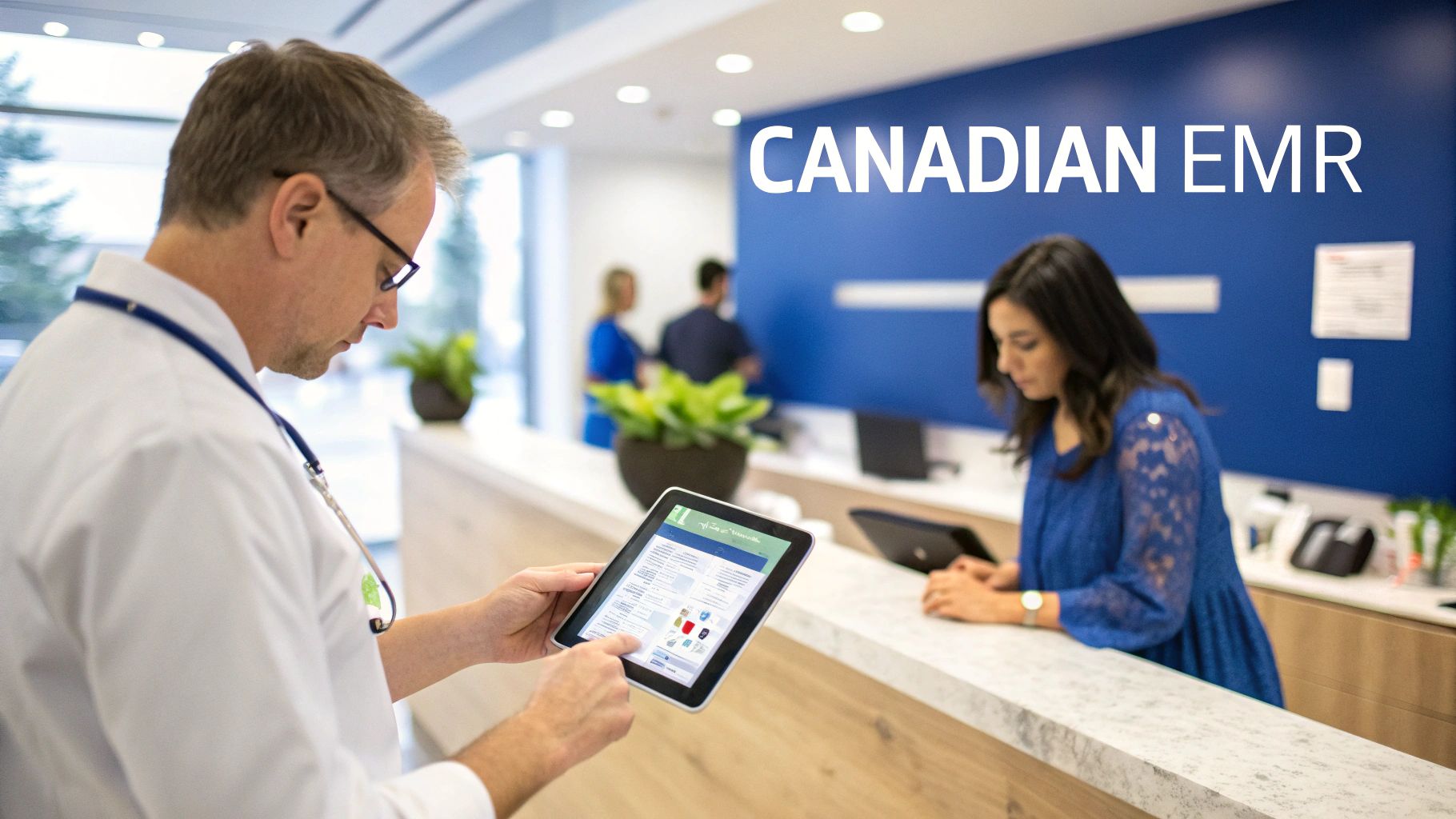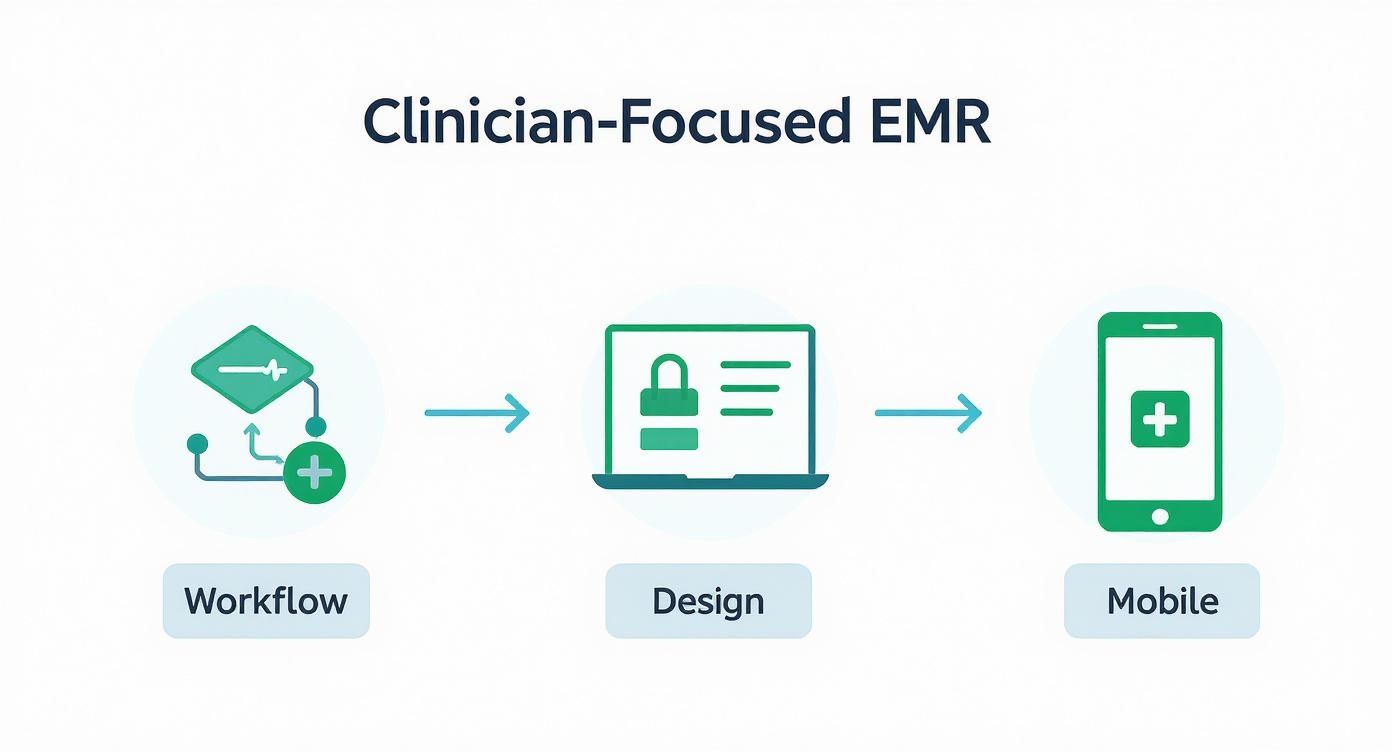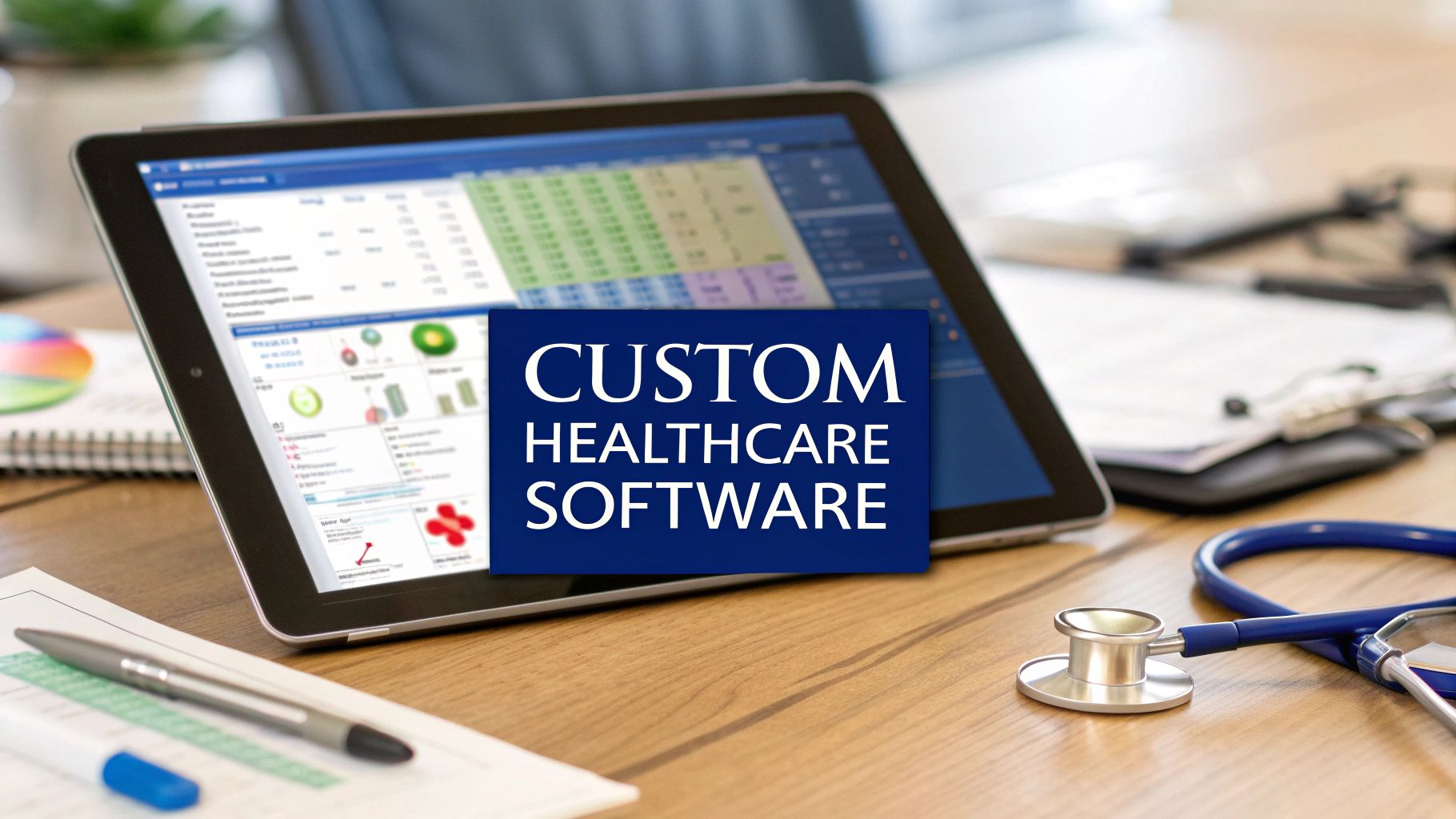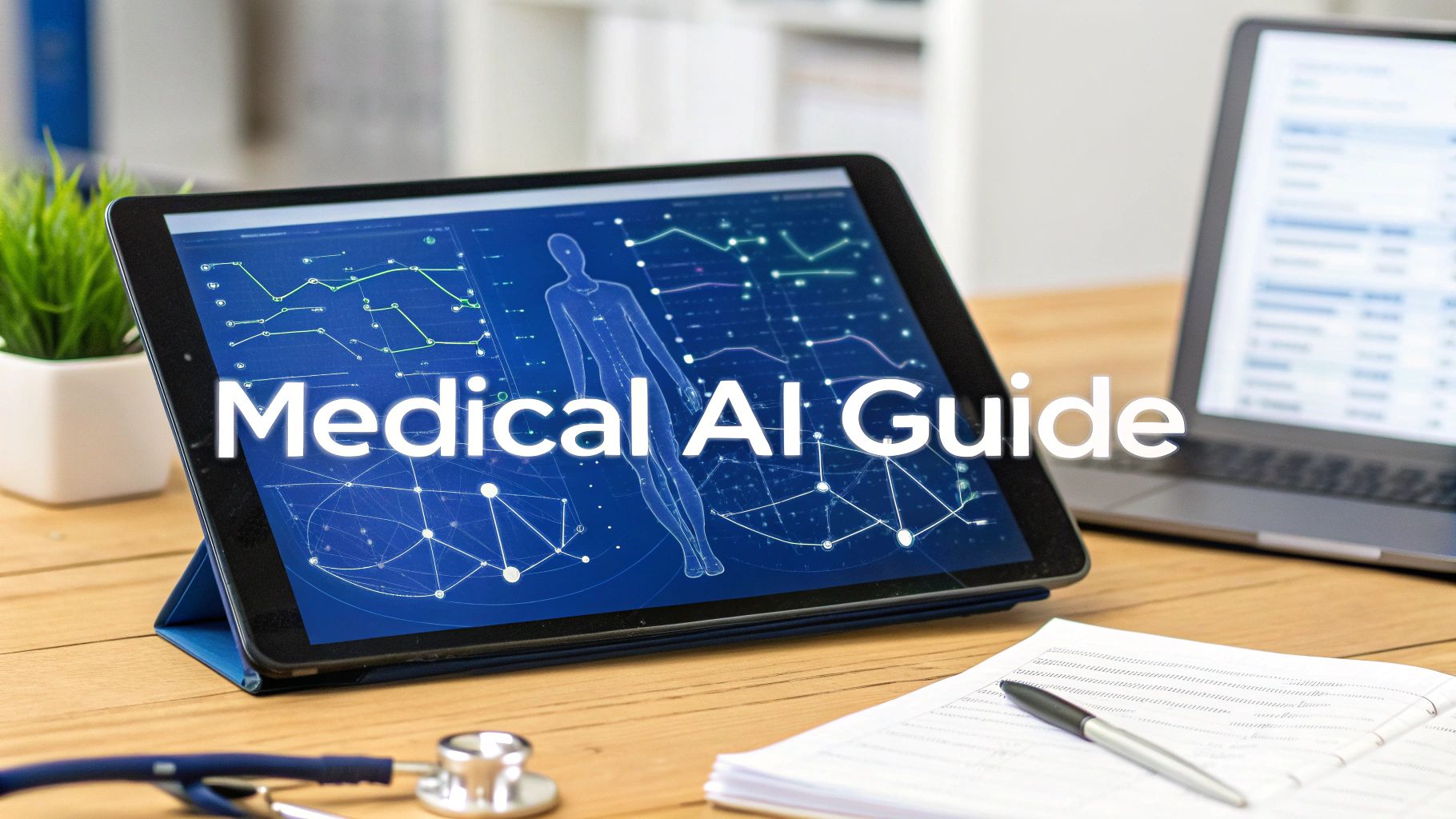Building an Electronic Medical Record (EMR) system for Canada isn't just a software project; it's about creating a tool that fits into a very specific, and often complex, digital health ecosystem. At the end of the day, the goal is always the same: help clinicians deliver better patient care, make administrative tasks less of a headache, and securely connect the dots between various provincial healthcare providers. Getting this right means you have to go deep on Canada's unique regulatory, clinical, and tech requirements from day one.
Decoding The Canadian EMR Landscape

Anyone looking to develop or buy EMR software in Canada quickly learns it's far more than a coding challenge. You're solving real, everyday problems for clinicians and patients who operate within a healthcare system that's managed province by province. There's a huge appetite for modern, intuitive systems right now. Why? This is because clinics are desperate to move off clunky legacy platforms, reduce the administrative load that contributes to physician burnout, and finally achieve that dream of seamless data sharing between family doctors, hospitals, labs, and pharmacies.
The Canadian market itself is a fascinating mix of big international players and agile local startups. You'll find giants like Epic, MEDITECH, and Oracle Cerner holding significant ground in the hospital space. But in primary care, domestic companies like TELUS Health and QHR Technologies are dominant forces. This creates a competitive landscape where the ability to connect and share data – interoperability – isn't just a feature, it's the price of entry.
The Big Move To The Cloud
One of the most important shifts happening right now is the migration to the cloud. Old-school, on-premise servers are being replaced by more nimble, scalable, and secure cloud-based platforms. This isn't just a tech trend; it's a strategic move that aligns perfectly with the bigger picture of digital health transformation in Canada. Cloud platforms make software updates easier, bolster security, and are essential for supporting the rise of virtual care and mobile health.
The numbers don't lie. Canada's Electronic Health Records (EHR) market is projected to climb from USD 1.54 billion in 2024 to nearly USD 2.0 billion by 2030. What's really telling is that a massive 87% of that revenue comes from web and cloud-based systems. The market has spoken, and it's looking up.
At its core, a successful Canadian EMR is a tool that understands and respects the distinct workflows of our healthcare professionals. It must be compliant by design, intuitive in practice, and built for a future where patient data flows securely and intelligently across care settings.
To help frame these moving parts, here’s a quick breakdown of the core pillars you absolutely have to get right.
Core Pillars Of EMR Development In Canada
| Pillar | Primary Focus | Why It's Critical In Canada |
|---|---|---|
| Regulatory Compliance | Federal (PIPEDA) & Provincial (e.g., PHIPA, PIPA) privacy laws, data residency. | Healthcare is provincially managed, so compliance isn't one-size-fits-all. A misstep here can be a project-killer. |
| Interoperability | HL7 and, increasingly, FHIR standards for data exchange. | To be useful, your EMR must talk to labs, pharmacies, hospitals, and other provincial systems. It cannot be an island. |
| Clinician-Centric UX | Intuitive design, efficient workflows, minimal clicks, mobile access. | High user adoption hinges on a design that saves clinicians time, not adds to their administrative burden. |
| Security & Data Residency | Robust encryption, access controls, and keeping all patient data on Canadian soil. | Protecting Personal Health Information (PHI) is paramount, and Canadian data sovereignty is a non-negotiable legal requirement. |
Getting a handle on these pillars is fundamental. For many, this involves partnering with teams that offer specialised IT services for the healthcare sector, as they already live and breathe this complex environment. Whether you build or buy, your checklist must include:
-
Provincial Compliance: You absolutely must adhere to the specific privacy laws and certification mandates of each province you operate in, like Ontario's PHIPA.
-
Interoperability Standards: Your plan for implementing HL7 and FHIR protocols has to be solid. This is how you connect to the rest of the healthcare world.
-
Clinician-Centric Design: If doctors, nurses, and office staff find the software frustrating, they won't use it. Prioritising their user experience is crucial for adoption.
Getting Canadian Healthcare Privacy Laws Right

If you're building an EMR for the Canadian market, you have to treat privacy and security as your ground zero. This isn't just a feature you can bolt on later. It's the entire foundation. Clinicians and their patients need to have absolute trust in your platform's ability to safeguard their most sensitive information.
Canada's legal landscape for health data is a complex web of federal and provincial laws. The federal Personal Information Protection and Electronic Documents Act (PIPEDA) provides a national baseline for how private companies handle personal information. But here’s the crucial part: healthcare is a provincial matter, and that’s where the rules get much tighter.
The Provincial Privacy Puzzle
Most provinces have their own health-specific privacy laws. These are often considered "substantially similar" to PIPEDA but almost always come with stricter, more detailed requirements. This means you can't just build for one province; you have to design your EMR to meet the highest compliance bar in any jurisdiction you hope to operate in.
Here are a few of the big ones you'll run into:
-
Ontario's PHIPA (Personal Health Information Protection Act): This is arguably the most robust piece of health privacy legislation in Canada. It sets out strict rules for "health information custodians" (doctors, hospitals, clinics) and their agents – a category that absolutely includes EMR providers.
-
Alberta's HIA (Health Information Act): This act governs how health information is collected, used, and shared within Alberta's health system, with very specific rules around patient consent and access.
-
British Columbia's FIPPA (Freedom of Information and Protection of Privacy Act): While not exclusively for health, FIPPA has major implications for health data, especially for public bodies and the software vendors they work with.
A rookie mistake is thinking PIPEDA compliance is all you need. In reality, provincial laws like Ontario’s PHIPA are what will truly shape your security architecture and data-handling protocols. Always design for the strictest applicable law.
This patchwork of laws directly impacts your development roadmap. For example, the idea of "consent" is far more detailed under PHIPA. Your EMR absolutely must be able to log who accessed a patient record, when they did it, and for what reason. This "audit trail" isn't a nice-to-have feature; it’s a non-negotiable legal requirement.
Data Residency Is Not a Suggestion
One of the most critical legal mandates in EMR software development in Canada is data residency. Simply put, all Personal Health Information (PHI) has to be stored and processed on servers physically located inside Canada. Provinces like British Columbia and Nova Scotia even have explicit laws demanding this.
This has an immediate, massive impact on your choice of cloud provider. You can’t just spin up a server in a US-based region, even if it’s run by a familiar global provider. You have to select a cloud service that has a confirmed Canadian data centre.
-
Amazon Web Services (AWS): Offers the Canada (Central) region in Montreal.
-
Microsoft Azure: Has several Canadian regions, including Canada Central (Toronto) and Canada East (Quebec City).
-
Google Cloud Platform (GCP): Operates a Canadian region based in Montreal.
Choosing a Canadian data centre is just the start. You must also ensure your entire data pipeline, including all backups and disaster recovery sites, also lives within Canada's borders. Getting data residency wrong can lead to crippling legal penalties and a total loss of trust in the market. Many of these foundational compliance principles are shared across medical software, a topic we explore more in our guide on healthcare app development in Canada.
Implementing the Right Controls
Beyond where the data lives, your EMR has to be armed with robust security controls to protect it. We're talking about much more than a simple username and password.
Think in layers of defence:
-
Access Controls: Implement role-based access control (RBAC) from day one. A nurse, a physician, and an admin all need different levels of access, and your system must enforce that.
-
Encryption: Data must be encrypted everywhere. That means "at rest" while it's sitting on a server's hard drive and "in transit" as it moves between the server and a user's device. No exceptions.
-
Regular Audits: Your system needs to log every single interaction with patient data. These audit logs are indispensable for investigating potential breaches and demonstrating your compliance with regulators.
These technical requirements aren't arbitrary; they are direct translations of the legal framework. By baking these privacy and security principles into your EMR from the very beginning, you’ll build a compliant, trustworthy system that's actually ready for the Canadian healthcare market.
Building an EMR Clinicians Actually Want to Use
You can tick every box for technical compliance and pack an EMR with powerful features, but if it’s a nightmare to use, it’s a failure. A system that adds clicks, complicates simple tasks, or fights against a clinician’s natural workflow will be met with resistance, poor adoption, and ultimately, be a waste of investment.
The single greatest measure of success for any EMR in Canada is whether it makes a clinician's day easier, not harder.
This is where user experience (UX) and user interface (UI) design move from a nice-to-have to the most critical part of your project. After all, more than 75% of physicians report that a well-designed EMR directly helps them deliver better patient care. The goal isn’t just to build software; it’s to build a tool that feels like a natural extension of their work, not another administrative burden.
Designing for Real-World Clinical Workflows
To build an EMR that feels intuitive, you have to get out of the boardroom and into the clinic. Understanding how Canadian healthcare professionals actually work means going far beyond a feature checklist and immersing yourself in the high-pressure environments where care is delivered.
Think about it: a family doctor’s workflow is worlds apart from a hospital nurse’s or a specialist’s medical office assistant. The doctor needs to document patient encounters, review lab results, and fire off prescriptions with lightning speed between appointments. The nurse is likely focused on charting vitals and administering medications at the bedside, while an administrator is juggling schedules and billing codes.
Your design process has to be built around these distinct roles:
-
Shadowing Sessions: There's no substitute for direct observation. Watch how they currently use E-prescribing tools. See the workarounds they’ve invented to deal with clunky software. You'll learn more in an afternoon of shadowing than in a week of meetings.
-
Role-Based Dashboards: A one-size-fits-all interface just doesn’t work. A physician logging in should immediately see their daily appointments and urgent lab results. An administrator needs a billing overview and scheduling requests front and centre.
-
The Click-Reduction Test: For common tasks like renewing a prescription or charting a routine visit, count the clicks. Your mission should always be to shrink that number. In a busy clinic, shaving five seconds off a task adds up to hours of reclaimed time every single week.
An EMR should adapt to the clinician, not the other way around. Every design choice must answer the question, "Does this save the user time and mental energy?" If the answer is no, it's the wrong choice.
Key Features That Drive Adoption
Focusing on the right features can be the difference between an EMR that’s merely tolerated and one that’s genuinely loved. While every speciality has its unique requirements, a few high-impact features are universally valued by Canadian healthcare professionals.
Intuitive Charting and Note-Taking
Clinicians spend a huge chunk of their day documenting care. The EMR’s job is to make this process as painless as possible.
-
Smart Templates: Offer customizable templates for common visits (e.g., a diabetes check-up, a pediatric wellness visit) that pre-populate with standard fields, saving them from starting from scratch every time.
-
Voice-to-Text Integration: Let physicians dictate notes directly into the patient's chart. This is a game-changer for saving time and capturing more detailed notes.
-
Natural Language Processing: Go a step further and use AI to pull structured data, like diagnoses or medications, directly from those unstructured, dictated notes.
Seamless Integrations
An EMR can’t be an island. Its real power is unlocked when it connects smoothly with the rest of the Canadian healthcare ecosystem. This means building fluid, reliable integrations for:
-
Provincial Lab Systems: Results from systems like Ontario's OLIS or Alberta's Netcare should flow directly into the correct patient chart, automatically flagging abnormal results for review.
-
Pharmacy Networks: E-prescribing needs to be a seamless, two-click process that connects directly to the patient's chosen pharmacy, eliminating faxes and phone calls.
-
Hospital Information Systems (HIS): For patients moving between their family doctor and the hospital, the ability to securely share discharge summaries and consultation notes is absolutely critical for continuity of care.
Mobile Access Is Non-Negotiable
The days of clinicians being tethered to a desktop computer are over. They need secure access to patient information from anywhere; whether they’re on call, moving between exam rooms, or conducting a virtual care visit from home.
A responsive, mobile-first design that allows them to check schedules, review charts, and respond to urgent messages from a smartphone or tablet makes the EMR a truly indispensable tool for the reality of modern Canadian healthcare.
Architecting a Future-Proof EMR System
The technical architecture of your EMR is its blueprint for the future. Every choice you make here, from where the data lives to how it talks to other systems, will define the system's lifespan, its ability to scale, and how it adapts to the shifting needs of Canadian healthcare. Getting this right from the start means building a foundation that’s secure, connected, and built to last.
One of the first big forks in the road is deciding where your system will be hosted. Do you invest in on-premise servers, or do you go with a cloud-based model? While keeping everything on-premise gives you direct physical control, it also comes with a hefty price tag for hardware, plus the ongoing headache and cost of maintenance and scaling.
This is why cloud hosting has become the standard for modern EMR software development Canada. Using a Canadian data centre from a provider like AWS, Azure, or Google Cloud takes the weight of hardware management off your shoulders. It offers predictable monthly costs and can scale up or down almost instantly. Most importantly, it keeps you compliant with the strict data residency rules found in provincial privacy laws.
Choosing Your Architectural Model
Beyond hosting, you need to think about the software's internal structure. A classic monolithic architecture, where every component is woven into a single, massive application, can seem faster to get off the ground. The problem is, these systems become incredibly difficult to update and maintain down the road. A tiny change in the billing module could accidentally break the appointment scheduler, making the whole thing rigid and fragile.
A much more modern and resilient approach is a microservices architecture. This strategy breaks the EMR down into a collection of small, independent services. Imagine the patient scheduling system, the e-prescribing tool, and the clinical notes feature all running as separate, self-contained applications. This setup lets you update, scale, or even replace one piece without touching the rest of the system. The result is a far more flexible and robust EMR.
Making Interoperability Non-Negotiable
For an EMR to be of any real value in Canada's healthcare ecosystem, it can't be an information island. It has to speak the same language as hospital systems, provincial lab networks, pharmacies, and public health agencies. This is where interoperability standards are absolutely critical.
-
HL7 (Health Level Seven): For decades, HL7 has been the workhorse for exchanging clinical and administrative data. It's the dialect that most legacy systems in Canadian hospitals and labs are still using.
-
FHIR (Fast Healthcare Interoperability Resources): FHIR is the new standard, and it's built for the modern web. It uses RESTful APIs to make sharing data much simpler and more powerful. Any EMR built today must have a solid FHIR-based API strategy to connect with patient portals, mobile health apps, and the next wave of healthcare technology.
My advice? Build your EMR with a "FHIR-first" mindset. It's one of the single best architectural decisions you can make. You’re not just building for today; you're preparing your system for a future of connected care, where data needs to flow seamlessly and securely between providers, patients, and innovative new tools.
The infographic below shows how these architectural decisions ultimately serve the clinician, from mapping their daily workflow to designing a mobile-friendly interface.

This really drives home the point that your technical foundation must always support the practical, day-to-day needs of the people using the software.
The Role of a Smart API Strategy
Think of your API (Application Programming Interface) as the front door to your EMR. A well-designed API strategy transforms your system from a closed-off product into an open platform. This allows other authorised applications – a new telehealth service, a specialised diagnostic device, or an AI analytics tool – to securely plug in and share data.
This ability to extend the system is what truly future-proofs it. You can't possibly predict every tool a clinic might want to use five years from now. But with a powerful API, you give them the freedom to integrate new solutions as they appear.
Finally, a crucial part of your architecture is planning for the worst. You need a rock-solid disaster recovery and business continuity plan that details exactly how you'll handle data backups, system restoration, and keeping things running during an outage. For help drafting these essential policies, you can use a Free Disaster Recovery & Business Continuity Plan Generator. This ensures that no matter what happens, patient data remains safe and care can continue without major disruption.
Finding The Right Canadian EMR Development Partner
Picking the team to build your EMR is arguably the most important decision you'll make. This isn't just about hiring developers; it’s about finding a long-term strategic partner who lives and breathes the unique world of Canadian healthcare, privacy law, and clinical reality.
The right team can mean the difference between a system that clinicians actually use and a very expensive piece of shelfware.
There’s a reason a partner based in Canada is a massive strategic advantage. They’re already living in the regulatory environment, so they get the subtle but critical differences between PIPEDA and provincial laws like Ontario's PHIPA from the get-go. This local knowledge isn't a bonus; it's essential for avoiding catastrophic compliance mistakes and building Canadian data residency into the EMR's DNA, not bolting it on as an afterthought.
Vetting Potential Development Partners
When you start looking, your checklist needs to go way beyond technical skills. You’re hunting for a team with deep, demonstrable domain knowledge in Canadian health tech. A slick portfolio is a good start, but you have to probe to see if they genuinely understand the specific hurdles you're about to face.
Here are the key areas to dig into:
-
Proven Healthcare Experience: Ask to see case studies of EMR or health-tech projects they’ve built specifically for the Canadian market. What were the results? What tough problems did they solve?
-
Regulatory Fluency: Listen to how they talk about compliance. They should be able to speak confidently about their process for handling Privacy Impact Assessments (PIAs) and Threat Risk Assessments (TRAs). If they stumble here, that's a major red flag.
-
Interoperability Know-How: Grill them on their experience with HL7 and, even more critically, FHIR. A partner worth their salt will have a clear, FHIR-first strategy for building APIs that can actually talk to provincial health information networks.
A partner’s true value isn’t just in the code they write, but in the questions they ask you. A great team will challenge your assumptions and bring their own experience to the table, making your product better, safer, and more compliant than you initially envisioned.
Key Questions To Ask Before You Sign Anything
Once you've got a shortlist, it's time to get down to brass tacks. The answers to these questions will tell you everything you need to know about their process, real-world expertise, and whether they're the right fit for your EMR software development Canada project.
-
How do you design for clinicians, not just for a spec sheet?
Look for answers that involve getting their hands dirty. They should talk about shadowing doctors, mapping out clinical workflows, and building prototypes that they put in front of real users for feedback – over and over again. -
Walk me through your security and data residency protocols.
The answer must be unequivocal: they use only Canadian-based cloud infrastructure (like AWS, Azure, or Google Cloud) for all data, including backups and logs. They should also be able to detail their approach to end-to-end encryption, role-based access controls, and regular third-party security audits. -
What does our relationship look like after launch?
The work isn't done when the EMR goes live. You need to understand their model for support and maintenance. A true partner will have a clear, predictable plan for handling bugs, pushing security patches, and rolling out future features.
Understanding The Vendor Landscape
The Canadian market is a mix of global heavyweights and agile local specialists. While giants like Epic Systems Corporation, which captures 41.3% of the hospital EHR market, and MEDITECH dominate the hospital sector, there's a thriving ecosystem of specialised development firms that are perfect for custom builds. You can find more data on the top vendors in Canadian hospitals to understand the broader ecosystem your EMR will need to interact with.
Choosing a partner is also about finding a cultural and operational fit. A massive consultancy might be right for a government project, but a focused, specialised firm often provides the agility and direct attention needed to build a new EMR from the ground up. Our guide on custom healthcare software in Canada dives deeper into selecting the right type of partner for your specific goals.
Ultimately, a clear, comprehensive contract that spells out deliverables, timelines, and intellectual property ownership is the final, crucial step in launching a successful partnership.
Got Questions About Building an EMR in Canada? Let's Clear Things Up.
Diving into the world of Canadian EMR development always kicks up a lot of questions. I hear them all the time from clinics, hospitals, and even tech startups looking to break into the space. Who are the big players you need to worry about? What's a realistic budget? How do you even begin to tackle provincial certifications?
Getting straight answers to these practical questions is the first step in mapping out a successful project. Let’s break down some of the most common queries I encounter.
Who Are The Biggest EMR Vendors In Canada?
The Canadian EMR market is really two different worlds: hospitals and primary care clinics. You have to know who runs each. In our hospitals, Epic is the undisputed leader, holding over 41% of the market share. If you're building anything for a hospital, you're almost certainly going to need to integrate with them.
Right behind Epic, you'll find a couple of other major players in the hospital setting:
-
MEDITECH: They've got a solid foothold with 22.4% market share.
-
Oracle Health (formerly Cerner): Another significant presence in acute care that you can't ignore.
Now, step outside the hospital doors and into a local clinic, and the picture changes completely. Here, Canadian-grown companies dominate. Names like TELUS Health, which has bought up several EMR brands like Kroll, Med-Access, and PS Suite, are everywhere. The other giant is QHR Technologies, famous for its Accuro EMR. Knowing this landscape isn't just trivia; it's essential for your interoperability strategy. Your software has to play nicely with these established systems.
How Much Does Custom EMR Software Cost In Canada?
This is always the million-dollar question – sometimes literally. The truth is, the cost can swing wildly depending on what you're trying to build.
For a smaller, independent clinic that needs a straightforward custom EMR, you could be looking at a starting point somewhere between $75,000 and $150,000. This would typically cover the core essentials: charting, scheduling, and maybe some basic billing functionality.
But if you’re aiming for an enterprise-grade system for a hospital network? That’s a different league entirely. A platform with a patient portal, telehealth features, sophisticated analytics, and the complexity of meeting multi-provincial compliance rules will easily pass the $500,000 mark and can stretch into the millions.
What really drives the cost up? It's always the same three things: the number of third-party integrations (think labs, pharmacies, provincial health databases), the intricacy of the user interface, and the painstaking work needed to lock down compliance with Canadian privacy laws like PHIPA and PIPEDA.
What Is The Difference Between An EMR And An EHR?
People throw these terms around as if they're the same thing, but the distinction is crucial, especially when you're talking about the future of Canadian healthcare.
An EMR (Electronic Medical Record) is the digital equivalent of a patient's paper chart within a single clinic. It’s the record of their treatment history at that one location. It’s an internal tool.
An EHR (Electronic Health Record) is the big picture. It’s designed to be a comprehensive, shareable view of a patient's total health story, pulling information from all their different care providers. Your family doctor, the specialist you saw last year, that hospital visit – the EHR brings it all together.
When you hear organisations like Canada Health Infoway talking about a connected health system, they're talking about building a national EHR ecosystem. The whole point is to get data out of siloed EMRs so it can flow securely between providers, creating that complete patient history.
What EMR Certifications Are Required In Canada?
This is where so many projects get derailed. There is no single, federal EMR certification in Canada. It’s all handled province by province, and each one has its own rulebook.
Take Ontario, for example. Ontario Health runs a mandatory EMR validation program. If you want your software to connect to vital provincial services like the Ontario Laboratories Information System (OLIS), you absolutely must pass their validation. It's not optional. Many other provinces have similar conformance or validation programs, and passing them is often a prerequisite for clinics to get funding for adopting your software.
The review process is always intense and zeroes in on a few key things:
-
Security and Privacy: You have to prove, without a doubt, that your system can protect Personal Health Information (PHI) according to that province's specific laws.
-
Interoperability: Can your system talk to other systems? You'll need to show it can handle data exchange using standards like HL7 and, more and more, FHIR.
-
Clinical Workflow Functionality: Does the software actually work for a busy Canadian doctor or nurse? They'll test it to make sure it supports real-world clinical tasks effectively.
Getting certified isn't just a checkbox; it's a massive milestone. For any EMR aiming for serious adoption in Canada's public health system, it’s non-negotiable.
Building a compliant, user-friendly EMR requires a partner with deep expertise in the Canadian healthcare landscape. At Cleffex Digital Ltd, we specialise in developing secure, innovative, and scalable software solutions that meet these unique challenges head-on. Explore our custom software development services to see how we can help bring your vision to life.








